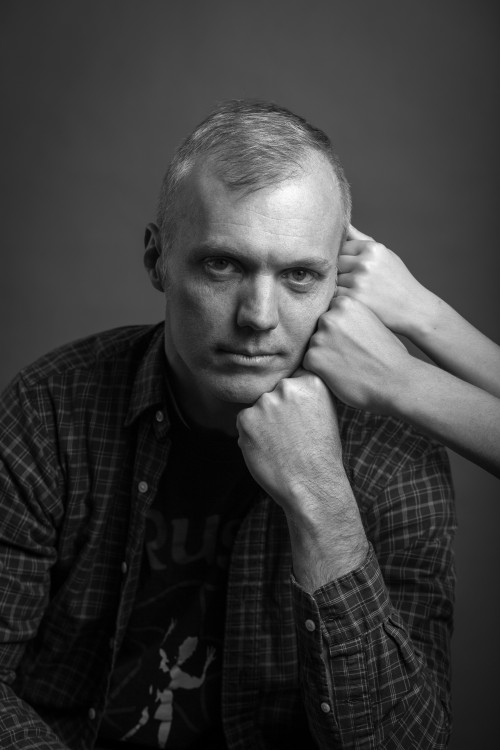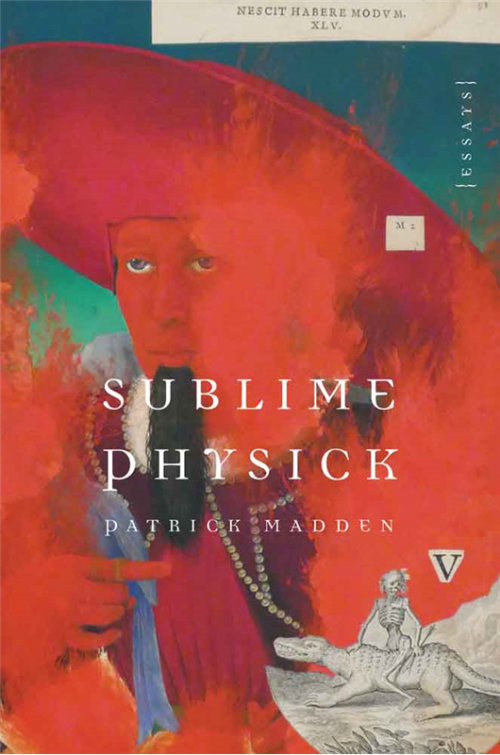The infinite suggestiveness of common things… —Patrick Madden
Sublime Physick: Essays
Patrick Madden
University of Nebraska Press, 2016
244 pages, $24.95
.
In the last sentence of his postscript to “Independent Redundancy,” the mammoth centerpiece essay of his new collection, Patrick Madden quotes Gide: “Everything has been said before, but since nobody listens we have to keep going back and beginning all over again.” This might be just a bit too morose to serve as an unqualified summation of Madden’s essayistic perspective, but it’s pretty close. To read a Patrick Madden essay is to interface with the mind of an engaged, self-conscious thinker. Actually, that’s not quite right: It is to interface with Madden’s curation of the minds of many thinkers within the expanse of his own.
Madden is not a hoarder of his thoughts or his words, or the words of his many sources, and he frequently seems more interested in exploring mysteries than creating them. In his first collection Quotidiana (2010), Madden declared the essay “an open, leisurely form, somewhat allergic to sensationalism,” and the primary intention of the essayist to “make the mundane resplendent with their meditative thoughts.” In Sublime Physick, his second collection, he continues exploring “the infinite suggestiveness of common things”—spitting hockers, turning 35, being recognized in a public place, temporarily losing his children—while expanding upon a tendency he intimated in Quotidiana of blending his sources into his own thoughts and sentences to the extent that it’s sometimes difficult to tell where his own thoughts begin or end. This will probably be the most divisive element of Sublime Physick’s otherwise gentle, reflective style: Either you are carried away into the free-flowing stream of voices commingling under Madden’s umbrella, or you are confounded by his seeming unwillingness to settle on a central voice or thematic concern.
Madden does his part to prepare the reader in “Fisica Sublime,” the “introduction” which is also the second essay of the collection. After explaining his choice of placing the “introduction” second in the collection, Madden spends most of the essay giving the etymology, metaphorical significance, personal associations, multiple spellings, and binary structure of the essay’s and the book’s title(s), concluding:
Perhaps, I’m beginning to think, everything we think we know is a kind of sublime physic, an abstraction derived from concretion and a double-aspected entity that we think we know in two distinct forms, yet is really a unity: matter-energy, space-time, mind-body, emotion-intellect, self-others, inside-outside, nonfiction-fiction; you could go on and on listing apparently opposed binaries and find, again and again, that where they meet is beauty.
These beautiful binaries comprise the nucleus of the collection’s essays, whose ostensible subjects range from Madden’s travels with recently deceased Uruguayan poet/storyteller Eduardo Galeano, to the brief disappearances of two of his six children, to a midlife non-crisis, numerous meditations on time and its discontents, and the acquisition of a bass guitar.
And that’s just the first half of the book. Much of the second half is taken up with just two essays, the first of which, “Independent Redundancy,” can fairly be called the opus of the collection. In thirty-six sections that seem to be written from at least eighteen points of view, Madden explores the phenomenon of the title, a term Madden coins “to describe the phenomenon of two or more individuals coming up with the same idea without any cross-pollination or shared influence.” The essay trots out a set of cultural referents seemingly impossible for one head to hold, unified mostly by representing different cliques of the same school of thought. Following are some notable juxtapositions and conversations.
Madden opens the essay and comes back numerous times to the phenomenon in popular music of the independently redundant melody, like the one shared by George Harrison in “My Sweet Lord” and the Chiffons in “He’s So Fine,” and by Coldplay’s “Viva La Vida” and Joe Satriani’s “If I Could Fly.” He even traces back the latter pair, in a connection one can guess only he has made, to the Argentine band Enanitos Verdes (Little Green Men). At least as interestingly, Madden also addresses the more obvious technique in modern hip-hop and mashup culture of sampling – direct “quotation” of previously recorded material, most times without citation, a technique, interestingly, that Madden consciously practices in his own essaying. As usual, most musical references somehow lead back to Montaigne or the band Rush.
He spends less space but as much energy on the nature of innovation and discovery in the sciences, positing most great advances as the cumulative work of many— “the result of convergences in ideas, materials, and possibilities”—rather than “the result of genius operating in isolation.” He points out that though the discovery of sunspots, the law of conservation of energy, and the invention of the airplane were all products of independent, synchronous work by numerous thinkers, “our mythologies tend to give full credit to a single inventor.” This leads Madden to ponder the place of free will in this process:
It occurs to me that the struggle between models of determinism…applies to invention as much as individual (or group) destiny, invention being a subset of destiny, and that all are opposed, in some way, to any real model of creativity. Rather, if we stipulatively determine (determine!) that invention means an unpredictable, unexpected, not inevitable creation and that discovery, as is binary, is that which—like a rock in the path of a tiller—will inevitably be turned up, then that is the same struggle. And this would mean that those who believe invention inevitable really really mean that there is only discovery, not invention…
Of course, Madden is not afraid to turn the scope inward. He peppers examinations of his own writing style throughout the essay, from examination of influences like Woolf, Borges, Lamb, and Hazlitt, to farcical interactions with various artificial intelligence devices, robots, and computer-generated feedback services, to his surprised reaction and subsequent self-analysis after a friend tells him he’s a postmodern writer. He decides he’s postmodern mostly in that “I am painfully metaliterary in my thinking.” Perhaps the most singular purpose to this self-analysis (or written-self-analysis) is, in his words, “to wave at the attentive reader, calling attention to the artifice, the fact that this is a creation made of language; it is not the thing it describes.”
Each of the 36 parts echoes independently and redundantly, while Madden stops for breath only occasionally to project himself on the reader:
What if we are our book but our book is not us? What if this independent redundancy spins out of control and the inadvertent plagiarism becomes complete? (184)
…
…whatever we may convince ourselves, we will never know it all, and no matter our cries of originality, we are ever repeating, singing back the melodies we heard somewhere before, whether we remember or not. (222-3)
As if to pull in the reins after the freewheeling “Independent Redundancy,” Madden finishes the collection by meditating in its final essay on fixity. As if in counterpoint to the multitude of voices, influences, and points of view in the previous essay, Madden situates “Fixity” firmly in his own, starting at a centuries-old grave in Greenwich, England and moving outward to the situation of Greenwich as earth’s prime meridian and finally addressing the gathered crowd with “how you necessarily apprehend my essay, dear reader: by depending on my observations as I in turn depend on the observations of others, near and far, here and long gone.”
Which is all fine and would be a fitting theoretical tie-in to, even justification for, the multitude of voices and echoes he invokes through the previous essay. But Madden goes deeper into himself, deeper into his own fixed point in the landscape, or rather a fixed point adjoining his. As he was traipsing through Greenwich, “111 degrees 52 minutes 24.1608 seconds west of me,” Madden’s wife felt the surging limbs of what would be their fifth child within her and remembered the ghost-child they lost a year and a half earlier, “realiz[ing] with a start that had this lost child come to term, there would have been no time for this new person inside her now, so strikingly active so near to advent; that the loss of one is the profit of another.”
And thus the essay and the book end with a beginning, a birth, that might have been a continuation had circumstances, fate, or whatever shrugged and begun a family a year and a half earlier. The forces that shaped Madden’s life and words would have had an entirely different prime meridian, his family started from a different point, the quotidian moments given substantially different context, all built upon “rigid foundations and relative freedom” from which “we flail against nothingness or take stock from temporary origins and movable objects.”
—John Proctor
NC
John Proctor lives in Brooklyn, New York with his wife, two daughters, and Chihuahua. His publications include Atlas & Alice, The Weeklings, Essay Daily, The Normal School, The Austin Review, DIAGRAM, Superstition Review, and Underwater New York. His essay “The Question of Influence” was a recent Notable selection in The Best American Essays 2015, and his essay “The A-Rod of Ballhawking” was nominated for a 2016 Pushcart. He teaches academic writing, media studies, and communication theory at Manhattanville College. You can find him online at NotThatJohnProctor.com/.
.
.


